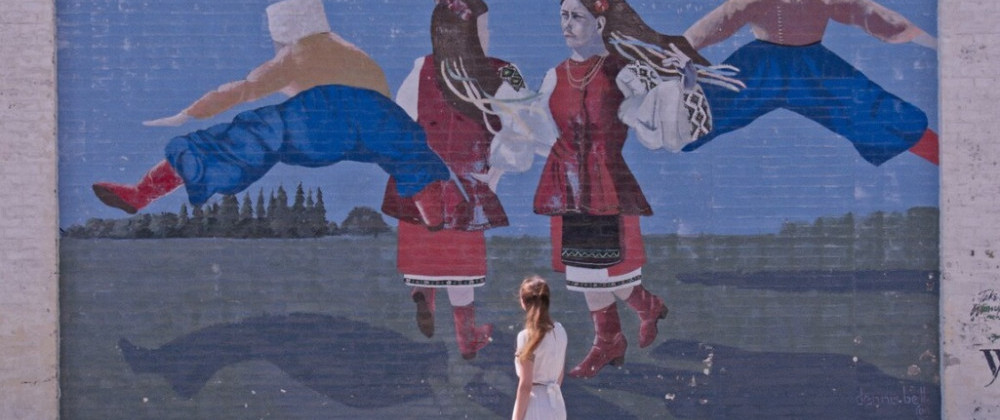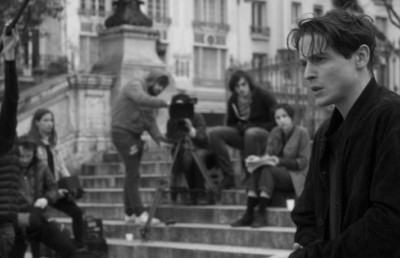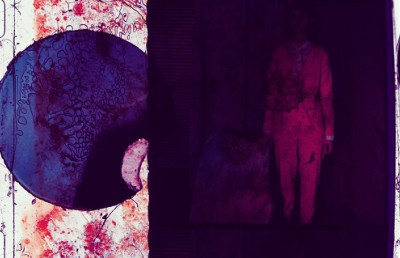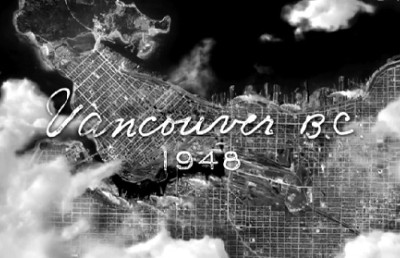Festival of Nouveau Cinema (FNC) 2022: Three Stand Out Canadian Features

Diaspora (Image source, Eagle Vision)
Diaspora (Deco Dawson, 2022, Canada) is the debut feature by long time Guy Maddin collaborator Deco Dawson, who makes something that could not be farther in tone and style from his work with Maddin, which has always been stylized to an arcane level. Here he directs (and writes, edits) an intimate character study about a young, gorgeous twenty-something Ukraine immigrant named Eva, played by newcomer Yuliia Guzhva, who arrives in North Winnipeg, like an alien landing on earth. Deco’s camera loves Eva, whose face seems made for a camera. But as beautiful as Guzha is, Dawson’s camera is as equally enamored with the North End of Winnipeg, which is where young Eva settles, a derelict disenfranchised neighborhood where very few of its denizens seem to speak English, and stores feel stuck in the 1980s (or earlier). The press release notes how the script features 25 languages, which just might make it the most ethnically diverse film ever made. And to place the viewers in Eva’s shoes (so to speak) the only dialogue that is subtitled is the Ukraine spoken by Eva, and one other Ukraine character she finally meets in the film’s (magic realist?) final scene. Stylistically the press release evokes Jim Jarmusch (most assertively, Stranger Than Paradise), Ulrich Seidl, Aki Kaurasmaki, Ramin Barhami, and Jacques Tati.
In terms of its emphasis on the city’s urban architecture I would also liken it to Sean Baker’s Florida Project, which also lends an empathetic feel to its motley group of disenfranchised ‘hidden homeless’ a stone’s throw away from Disneyland. The focus on a disenfranchised community and the delicate photographic attention paid to the buildings, storefronts and architecture of the neighborhood is reminiscent of Florida Project. The frequent use of long shots and extreme long shots and closed off spaces (characters shot up against walls and side of buildings) functions to underscore Eva’s sense of cultural dislocation, which is most directly felt in her constant search for human interaction, thwarted by the cross-fire of contrasting languages. At times Eva is framed as a miniscule presence against huge, stenciled lettering (Rutherford Mill & Lumber, Wawel Meat Market, Western King Manufacturing). A wonderful graffiti above where Eva is sitting on the ground reads “This Is Native Land, 1491”. Most of these moments, like the one where she enters a thrift shop wanting to buy a vacuum cleaner, a video shop trying to rent Ukrainian films, or a vacuum store trying to buy something she can afford, are mostly humorous, at times very funny.
But under the humour is a sadness and sense of frustration. The scene at a Croatian bar where she tries to convince a burly young Croatian named Vilmos to join her on the dance floor is one of the sexiest scenes I’ve seen in a long while. Eva is so desperate for human contact that she is willing to go to embarrassing ends. She asks Vilmos out on a date but it becomes a night with physical gestures trying to explain language. Somehow they make contact, eat, share some laughs, but the night ends poorly when an inebriated Eva vomits on Vilmos while kissing. She ends up so starved for physical contact that she surprises Vilmos at his car park job and forces him to have sex in a stairwell, putting Vilmos at risk of losing his job. Eva displayed a similar recklessness a few scenes earlier on her job when she and the only other young co-worker, a Philippine woman, upsets the German female owner when they get into a feather fight with a machine used to inject feather into down coat insoles.
Diaspora is 146 minutes yet the content is filled with repetitive action. We are always with Eva but her routine is limited. We see her buying things, walking to and from work, smoking, sleeping, masturbating, phoning home, searching for any sense of Ukraine community in shops and Orthodox churches, or shooing a homeless Indigenous man who takes to breaking into her apartment for a night of sleep. Eva enters a meat shop which reminds her of the smells of home, but the store is Polish. Another shop is Hungarian. The owner of the clothier is German. The vacuum store owner seems Iranian.
Eva comes across a Ukraine import shop but is constantly frustrated by finding it closed. When she sees a Ukrainian Church from far off she excitedly runs to it but finds it closed. In one of the most gut wrenching scenes, she finally finds the import store open and wanders inside. She is so joyed at seeing objects, clothes, books, folkloric artifacts that remind her of home she begins to cry, but the tears of joy turn to frustration and anger when she can’t find a soul in the store, and leaves yelling in anger. The same happens when she dresses in her Sunday best for the church, only to enter and discover the church is now serving a Catholic Philippine community. Eva is so starved for human company that she even comes to miss the presence of a homeless Indigenous man who sneaks into her apartment to sleep on her couch.. The first time she wakes up and sees him on her couch she is terrified and kicks him out of the apartment. By the third time she makes him coffee. At the end she looks over sadly at the empty couch. The camera usually frames the storefronts frontally, making them feel like cardboard cut outs. The film is filled with wonderful huge storefront lettering and long gone corporate signage, with fading or cracked paint. The film is shot on location with found lighting, but the aesthetic effect is wonderful. For most viewers who may be living in more modernized cities looking into some of the stores Eva goes into will feel like visiting a place from some past. A laundromat that rents VHS tapes. A two storey store filled to the roof with used vacuum cleaners. Some of this backdrop makes the neighborhood feel timeless, clean of any signs of gentrification (for good and bad).
Eva is alone but not alone, since the point of the film is to demonstrate how many other immigrants, although more settled, are still clinging to their cultural past by continuing to speak their language and work together in common manual labour jobs. In the film’s final scene, which almost has an aura of make-believe or fantasy, we see Eva dressed in a traditional Ukrainian dress, one made by her mother we learn. She seems calmer, more at rest. She comes across a Ukrainian bookstore and enters. After a few moments an elderly Ukrainian woman comes out from the back to greet her in Ukrainian. The common words seem to be an immediate balm to Eva’s spirit. She appears overjoyed at being able to talk to someone in her language. She cries, the lady comforts her and tells her that Canada is a great country and people will love her (and there really is no hint of irony here, so Canadians can feel good). She says that she may not be able to help her much but can offer her a job at the store. Eva who is out of work, is happy. Before much more can be said the lady picks up her purse and asks Eva to look after the shop while she leaves for an errand. The film ends with Eva seated, somewhat shocked at being in charge of the store. The exchange feels so perfect that one must wonder if it actually happened. Or perhaps if the lady was not the owner but just a customer, leaving Eva in an uncomfortable position. I later learned from comments by the Production Designer Jon Van Winkle that he and his production team reconstructed an existing pawn shop into the store we see in the film, the Ukrainian Voice bookstore, which adds now to the magic realist feel of the scene. To quote Winkle from the Production Notes, “Bringing the Ukrainian Voice book store to fruition was an extraordinary experience for both the crew and those who knew the original storefront before it was shuttered and taken over by a pawn shop years ago. The set came together through a collaboration between the crew, pawnshop employees of the pawn shop and members of the Ukrainian community who generously shared their authentic furniture, books and artwork. Once the set was finalized, it was clear that we had achieved something special which was confirmed by the reaction of community members.” The film is notable also for being produced by Eagle Vision, a company that identifies itself as “the most prolific production company in Canadian history with Indigenous ownership” (from the same Production Notes). Other feature films produced by Eagle Vision include Orphan: First Kill; the feature doc Buffy Sainte-Marie: Carry It On, Finality of Dusk_, and the Indigenous-themed science-fiction film by Danis Goulet, Night Raiders.
Promenade Nocturnale (Ryan McKenna, 2022, Canada)
After watching The Father and Anthony Hopkins’ performance I thought I had seen the best filmic representation of that awful mental disease Alzheimer’s/Dementia, but I have found a contender in Promenade Nocturnale. While The Father relies largely on the performances of Hopkins as the sick character and Olivia Coleman as the daughter and the narrative’s play with temporality, Promenade Nocturnale goes even further by engulfing the very fabric of the film with the illness. Visually and aurally the film externalizes Ethel’s (an excellent Marie Brassard) confused, muffled, clouded mind with kaleidoscopic lighting and progressively muffled, echoey sounds. Frames become progressively smeared with colors and streaks. There are two main characters in Promenade Nocturnale , an elderly lady who is slowly succumbing to cognitive loss, Ethel (Marie Brassard) and her caring, very patient daughter Pam (Sarianne Cormier). In the opening scene Ethel returns home from a nocturnal walk where she sights some peculiar night workers dressed in yellow suits taking samples in the fields. She lives with a African American man who walks around the apartment. They never make eye contact. The man caresses her on the back and leaves and we never hear from or see him again. Soon we learn from Pam Ethel’s husband, who Ethel searches for in the house, is in fact dead. We can only assume this was the man in the earlier scene, Henri. In a very long, static take at the kitchen table Pam recites a story from her youth and Ethel watches, listens but barely reacts. This is our first hint that perhaps she has cognitive issues. Or is simply withdrawn because of her husband’s death. The image up to now is clear and legible, normal.
Each subsequent discussion between Pam and Ethel hints at more of Ethel’s mental health issues (an incident with a cigarette, forgetting that Henri is dead, not being able to put on her pants, etc.). One scene is particularly unnerving. Ethel is alone, the camera framing Henri’s bedroom, then the hallway, while Ethel frantically looks in and out of the rooms looking for Henri. The image darkens but the first formal sign of the film’s descent into Ethel’s sickness are the drone sounds, which have the tone of a horror film, with Ethel’s disturbing behaviour as frightening as a monstrous threat. Right after this scene, we get the first visual indication with some slight soft focus and light streaks. It is night. A hooded man exits Ethel’s second floor apartment and she follows after. As she walks under a bridge the image seems to be mirroring on itself, headlights seemingly flaring the image. Her nocturnal walks, filmed straight forwardly in the beginning, have now become a walk through a surreal house of mirrors. By the halfway point of this short film dialogue becomes sparse. A third character enters the fray, Pam’s older brother, Jef (Martin Debreuil). Visits with Pam become moments isolated in time, as she never remembers her daughter’s earlier visits. Ethel has long, rambling talks with Pam that make little sense. Several moments feature the daughter and mother alone in the apartment, being intimate, which seem a nod to Alexandre Sokurov’s Mother and Son (1997), which depicted a mother’s dying days with her son in a rustic cabin in a rural dacha setting. Although Ethel lives in the present in the city, the structure turns away from the present following Ethel’s own ruminations into her past, something common in dementia, where the person loses short term memory and falls further back into the past. Director McKenna is clever with his meaningful use of art. Some of the first signs of cognitive loss occurs first at late afternoon into nighttime, which doctors refer to as ‘sundowning’. It is common with sundowning for the inflicted to begin to wander and become anxious. The film’s title refers to this. And in the scene where Ethel is unable to change into her pajamas we see a large painting of three sunflowers above the headrest, a subtle reference to ‘sundowning’. As her illness deepens Ethel is seen more frequently in a setting which recalls her past: a farm with chickens, horses in a stream, beautiful wooded areas with flowers and trees.
Promenade Nocturnale is an exercise in concise storytelling. Short snippets are enough to depict Ethel’s decline. Shots of Pam selecting clothes, photos, Jef throwing items into a fire are an indicator that Ethel is being placed into a home for the elderly. The scenes in the residence are a clever blend of the real institutional space, giving way to a fantasy space where the residents sit in the middle of the woods. One shot sees Ethel walk down a wood panelled hallway to a locked door she tries to open, frustrating her. She is at the residence, but her mind is still at the home of her childhood. The way Mckenna frames Ethel in a flowery meadow, with the refracted sunlight and hazy sunlight shows the staunch influence of another great Russian filmmaker, Andrei Tarkovsky’s Mirror. As Ethel becomes sicker and retreats more into her inner shell, the film follows suit, the images becoming cloudy, like her mind, the sounds muffled and indistinct. Ethel becomes more removed from human contact, a stranger now to her son and daughter, and we see less of them, or when framed, are shot in doubling images, mirrored, or abstracted through saturated colors. In a touching shot near the end Ethel is on her deathbed, the camera framing her from bed level as Jef visits her for perhaps the last time, bending over to kiss her on the forehead. The last scene at the hospice is sad and touching. The film’s final few images which represent Ethel’s passage to death are as painterly as anything from Mother and Son, and look like some long lost impressionist paintings. The moment before death is depicted by a strong wind rustling through a dark forest. Which transforms into a luminous background with a dark shadowy figure standing in the foreground. Images such as these make Promenade Nocturnale one of the most visually and aurally rapturous films I have seen in a very long time, maybe since Sokurov’s own Mother and Son. And as truthful (if abstract) a depiction of cognitive loss as you are likely to see.
Anyox (Jessica Johnson, Ryan Ermacora, 2022, Canada)
Anyox is an assured experimental documentary on the once thriving North British Columbian mining town that is now relegated to the dubious distinction of “Canada’s largest ghost town” after the mines shut down in 1935 and its peak period population of 3000 all left except for a handful of people. A community reduced to a few made me think of the even quirkier Welsh film Enys Men (Welsh, Mark Jenkins, 2022), where a single occupant of a Cornish Island dedicates herself to meticulously charting the island’s vegetation. Both films share a concentration on human ecology and the environment.
The town Anyox was purchased by Granby Consolidated Mining Company in 1910. A quick tour of the history of the town reveals a long history of corporate expulsion of natural resources, starting with gold, copper, and other precious minerals. To provide energy for operations coal was shipped to Anyox to fuel smelters and eventually a hydroelectric damn was built in the early 1920s. Conditions fueled a forest fire in 1943 that caused further destruction. The documentary blends live footage filmed in Anyox today set against archival material to recount its economic, environmental and social history (only under 400 people were born on the lands of Anyox). The film opens with a striking long tracking shot following a worker on a 4 by 4 truck driving along the desolate remains of what looks like a quarry. The two and a half minute shot effectively encapsulates the Anthropocene force of the film: here it is, straight and to the point, the impact of human presence on this patch of earth. In the case of Anyox, it took a little over 25 years, the time from when Granby Consolidated Mining Company purchased the land (1910) to when it shut down operations (1935) to destroy the town for good. Like Enys Men, Anyox’s original footage is shot on celluloid, both 35mm and 65mm film stock, which enhances the inherent (if denuded) natural beauty of the landscape. The filmmakers let the mining company hang itself by presenting archival typewritten company letters (meant no doubt for internal circulation) providing information sheets that outline the extent of damage their mining is doing to the trees, flowers, and vegetation.
Directors Johnson and Ermacora dig into the mining company’s past with mimeographed newspaper clippings, company blueprints of the plants and archival footage inside the mines and surrounding areas. I was struck by one aerial tracking shot inside a factory that looked a lot like a similar factory shot from Eisenstein’s Strike. The emphasis the filmmakers place on the labor issues between workers and management makes the allusion to Eisenstein’s Strike particularly relevant, since a good amount of time is spent covering the development of worker rights during the years the mine was in operation (labor meetings, grievances, worker demands, union building, strikes, etc.).
The film achieves a strong emotional resonance by constantly cutting between archival black & white footage of a thriving mining operation and shots of what the plant locations look like today. The filmmakers must have been happily surprised to unearth such excellent archival mining footage, with impressive moving camera shots through the mine shafts and one particularly striking vertical movement (crane? elevator?) taking us from one level of the mine to another, all accompanied by ambient music. The contrast is augmented aesthetically by layering original ambient music over the silent archival footage but presenting the new footage with deadly silence. The camera in the contemporary footage is mostly (except for a few scenes following someone on a moving vehicle) slow and languid. Static, silent long takes capture a landscape dotted with old mining equipment. The slow pace is an apt reflection of the pace of life on Anyox today. If pace is even the correct word, since we see only two inhabitants, a man and a lady, identified in the credits as Lyle Munson and Linda Danielsen. Lyle seems to be a mechanic, keeping the equipment operable, while Linda charts ship courses on her laptop.
The film dramatizes (with voice actors) audio testimonies of survivors who lived and worked in Anyox, including a woman who recounts the many different languages and Nationalities of the people who worked there. And how workers who tried to unionize were rounded up, put on a barge and sent home by the company. We see in full close-up letters about worker organized grievance meetings and worker demands. One man named Marko recounts in VO his experience arriving in Anyox in 1925 and working in the mines and how his political consciousness arose thanks to reading Worker newspapers from his home Croatia, until they stopped arriving and he shifted to reading papers in other languages. He goes on at some length about the political underpinnings of the labor newspaper, the in-fighting between them and the government’s invested interest in curtailing any newspapers that had too much of a leftist bent. Mimeographed letters from 1933 outline the details of worker strikes. The nature of the labor force, the labor newspapers, evolving worker and class consciousness is an indicator of how much farther to the left North America was during the 1920s and early 1930s. Based on the amount of time the film spends on this, with audio witness accounts, letters on company letterhead, mimeographs of newspaper headlines, the filmmaker’s main point of interest (alongside the obvious environmental price) is the labor issue and how the legacy of the town is very much one of a Marxist Capitalist vs. Labor struggle. Not surprisingly, Jennifer Baichwal, director of Anthropocene: The Human Epcoh (2018), highly influential here and elsewhere to the sub-genre of ecological documentary, is named in a long list of “Special Thanks”.














